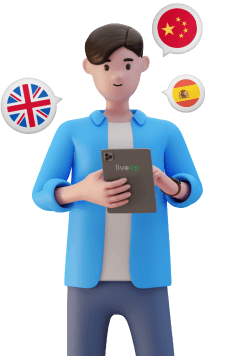
How Easy or Hard is Spanish to Learn? Let’s Find Out
Let’s now explore what makes this language accessible and intriguing to learn while also acknowledging the hurdles you might encounter.

Get a FREE guide!
Want to sound like a native English speaker?
Get our free PDF with top tips that work.

Check your email!
So, you’ve decided that you want to master this beautiful Castilian language? ¡Fantástico! (Fantastic!). But the burning question remains: “Is Spanish easy or hard to learn?” I’d say that it depends if you ask me.
Yes, the answer lies in your own experience. Spanish could be easy if, let’s say, you know how to speak Italian, the mother language of Marco Polo and Christopher Columbus. Meanwhile, it could be particularly challenging if you have no idea.
Learning Spanish can be a thrilling adventure
But it also has its hurdles. While others may find it difficult, learners from places like France🇫🇷 and Portugal🇵🇹 grasp Spanish quickly.
Let’s now explore what makes this language accessible and intriguing to learn while also acknowledging the hurdles you might encounter.
¿Es Difícil Aprender Español?—Is it hard to learn Spanish?
That’s one common query we often hear from learners who set their eyes on Spanish for varying reasons.
We’ll explore both sides of the coin, starting with what makes Spanish easy to understand for English speakers.
Vocabulary
English and Spanish share many cognates—words that look, sound, and mean the same things. The words “hospital,” “animal,” and “celebración,” to name a few, are easily recognizable to people who speak English, right?
Example:
When ordering “taco” in a Mexican restaurant, for instance, you’re essentially saying “taco” in both languages.
Pronunciation
Spanish is mostly phonetic. You will notice that you are practically required to pronounce words exactly as they are written. This makes it easier for learners to articulate words correctly.
Let’s use the word “mesa” (table) as an example. We pronounce it exactly as it’s written, “mesa” (meh-sah). See what I mean?
Verb tenses
While Spanish has a variety of verb tenses, you will find that we use some verbs more frequently in everyday conversation.
This simplifies the process of becoming fluent in Spanish, as learners can focus on mastering essential tenses first.
Understanding why Spanish is hard to learn
Essentially, there are aspects of Spanish that make it accessible, and there are also some hurdles to be aware of as a learner. Like the Spanish grammar, for example. It has its own complexities.
Let’s explore some of them below:
Similar vocabulary
Spanish and English were influenced by Latin and French, and they share the same language family. So, it’s not a surprise that they have similar words. But don’t get into a trap with this! It can be both an advantage and a disadvantage at the same time. False cognates can lead a Spanish learner to misunderstanding. For example, “ropa” means “clothes” in Spanish, it’s not the same as rope in English.
Gendered nouns
Unlike in English, where nouns referring to people don’t have distinct forms for men and women, in Spanish, nouns have genders: masculine forms for men and feminine forms for women.
This means you will need to learn which articles (e.g., “el” for masculine and “la” for feminine) and adjectives to use with each noun.
This shows how hard it is to learn Spanish for English speakers. It can be confusing since, as I’ve mentioned above, English doesn’t have gendered nouns.
Here’s an example to give you the idea: “La casa” (the house) is feminine, while “El perro” (the dog) is masculine. Notice the obvious change in nouns?
I mean, the “la,” which stands for “the” in the word “la casa,” and the “el,” which also stands for “the” in the word “el perro”? Another example is the name Spanish (or Espanõl). If we’re talking about a man from Spain, we’ll use Espanõl, while for a woman, we say Espanõla.
Verb conjugation
You will realize that verbs are conjugated to match the subject of the sentence. That is not the case with English. And it means you will need to learn the various verb forms, which can seem overwhelming at first.
Example:
The Spanish verb “ser” (to be) conjugates as “soy” (I am), “eres” (you are), “es” (he/she/it is), and so on.
As you can already see, learning Espanõl from scratch can be particularly challenging, given the few facts we have seen. And that’s not all.
Subjunctive mood
The use of the subjunctive mood in Spanish can be difficult to grasp as it’s used to express doubt, wishes, emotions, and hypothetical situations. It’s a complex aspect of Spanish grammar that requires careful attention.
The role of practice
Is Spanish hard to learn? Yes. And then no. Whoever said that practice is the mother of all success was absolutely right.
Regular practice, whether that is through conversation, reading, or writing, can influence your Spanish-speaking skills significantly. It can make what might seem hard for you today very easy and accessible.
Take conversational practice
Engaging in active conversation with your tutor or fellow learners is invaluable. It helps you build your confidence significantly.
You could join language exchange meetups or take advantage of the best language platforms to find a great tutor and conversation partner who has your best interests at heart.
Yes, and it’s easily the best way to grasp and speak Spanish with confidence. And speaking of language platforms, you will also agree that what they offer in LiveXP 1-on-1 lessons, the experience, and the quality of teaching you get are worth a lot more than what they charge you!
Learn Spanish with a private tutor to advance quickly
Why go through the trouble of trying it alone or joining the wrong courses when there’s a professional tutor on LiveXP who can easily help you overcome the challenges?
Here are several reasons why you should actually be thinking about considering 1-on-1 private lessons with a professional tutor on LiveXP:
- Personalized attention: You definitely want this if you’re looking to progress fast. Private tutors on LiveXP can tailor lessons to your specific goals and pace to ensure a customized and flexible learning experience.
- Immediate feedback: That’s right. With a private tutor, you receive instant feedback and correction, which helps you address mistakes and improve faster.
- Pronunciation practice: One-on-one sessions allow for focused pronunciation practice, which is a crucial aspect of mastering a new language.
- Confidence building: Individual attention can boost your confidence in speaking and understanding the language, as you can ask questions without hesitation.
- Flexible schedule: This goes without saying. Flexible scheduling accommodates your availability, making it easier to commit to regular lessons. Don’t you agree?
- Goal-oriented learning: Tutors can help you set clear learning goals and track your progress more effectively.
- Cultural insights: Although it comes last on my list, it surely is an important tip to take note of. LiveXP tutors may share cultural insights, which enhance your knowledge of the community you’re exploring, making the language come alive.
By learning Spanish 1-on-1 with a private tutor on LiveXP, you’ll be able to address and overcome the challenges more effectively and progress with ease.
Considering the Spanish language difficulty
The level of Spanish language difficulty can vary based on different factors. These factors include your previous experience in language learning and how committed you are to practicing.
While it’s true that some people have some sort of advantage, gendered nouns, and complex grammar are still tough challenges that get in the way.
But that shouldn’t scare you. No matter how hard it is to learn Spanish, with dedication and the right resources, you, too, can successfully navigate the challenges and master the language.
Lastly, it’s essential to keep in mind that acquiring a new language presents its own intricacies. Yet, for those who are truly dedicated, the journey (and the experience) are surely rewarding.
















